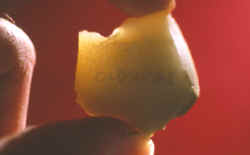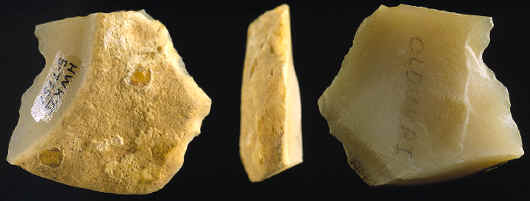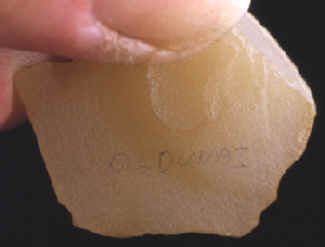|

OLDOWAN FLAKE
TOOL
LOWER PALEOLITHIC
OLDUVAI GORGE,
TANZANIA AFRICA
UNIVERSITY
OF CALIFORNIA--BERKELEY, DEPT. OF ANTHROPOLOGY COLLECTION

CLICK ON PICTURE FOR
VERY LARGE TRIPLE IMAGE
OLDOWAN FLAKE
TOOL
"THIS PICTURE SHOWS THE ORIGINAL ARTIFACT"
OLDUVAI GORGE,
TANZANIA AFRICA
UNIVERSITY
OF CALIFORNIA--BERKELEY, DEPT. OF ANTHROPOLOGY COLLECTION

CAST
#LP-1
OLDOWAN FLAKE
TOOL
HWK II, 5,7757
OLDUVAI GORGE,
TANZANIA AFRICA
UNIVERSITY
OF CALIFORNIA--BERKELEY, DEPT. OF ANTHROPOLOGY COLLECTION
This unmodified flake represents one of the most important stone tool
types made by Homo habilis 1.5 to 2 million years ago. This simple flake
tool was collected several years ago at Olduvai Gorge in Tanzania, Africa
by Desmond Clark and Louis Leaky. It represents the earliest stone tool
type that can be found on ancient hominid sites. Sharp edges on small
stone flakes have been used for hundreds of thousands
of years for many different daily tasks such as cutting into the hide of
an animal to procure food. Simple tool making experiments using "Kanzi
the chimp" to represent an early hominid have shown similar tool
making techniques for the purpose of acquiring food.
The first
deliberately manufactured stone tools were simple flakes struck off an
unmodified core (small piece of rock). This example is made of chert. Most stone tools from the
Lower Paleolithic Oldowan industry at Olduvai Gorge were made from the
more common basalt. Basalt is a coarser stone that doesn't allow for
reliable edge wear analysis like the denser chert with a higher silica
content. Edge wear analysis with the use of a scanning electron microscope
allows archaeologists to determine in some ways what types of materials
the edges of the stone tool was cutting.
This epoxy cast measures 1 5/16 inches long (33mm).
|
|
"REFERENCES"
1988,
"Encyclopedia of Human Evolution and Prehistory" Ian Tattersall,
Eric Delson and John Van Couvering, PP 387-392.
1994,
"Making Silent Stone Speak", Kathy D. Schick and Nicholas Toth, pp
135-140.
1994, "Flintknapping-Making And Understanding Stone Tools", John
C. Whittaker, pp 243-246.
|


